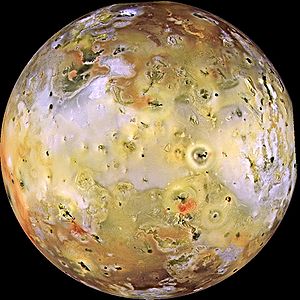Size: 3,632 km (2,257miles) wide, slightly larger than Earth's moon.
Distance From Jupiter: 422,000 km (262,230mi)
Io is made of rock with a melted metal core
Io's hundreds of volcanoes spew 11 billion tons of lave per year! What causes these huge eruptions?
The gravity of nearby Jupiter and other moons tugs at Io. The strong pull cause Io to stretch and bend. This motion causes friction (rubbing) inside Io. When you rub your hands together quickly for 30 seconds. Friction causes heat! The heat melts most of Io's rock. The melted rock flows up and shoots out as lava. The heat also explodes underground gas that makes lava spray really high! ( Uses resources and organized).



